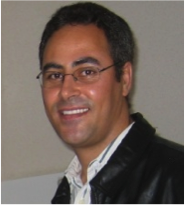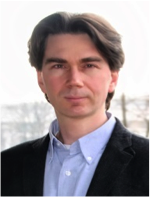Ecole d'été
Développements Théoriques et Applications
Samedi 07 Juin 2014
Campus Targa Ouzemour - Université de Béjaia
Organisateurs
Professeur Mohammed Saïd RADJEF,
Unité de Recherche LaMOS, Département de
Recherche Opérationnelle, Faculté des Sciences Exactes, Université de
Béjaïa (Algérie)
Cours
Saadi Boudjit - Maître de Conférences, Laboratoire L2TI, Université de Paris 13 (France)Théorie des jeux et réseaux de communications
Samson LASAULCE - Directeur de Recherche CNRS, Laboratoire des Signaux et des Systèmes (Gif-sur-Yvette), et Professeur au département de Physique de l’école Polytechnique (France)
Programme
8h30 – 9h00 : AccueilMatin : Saadi Boudjit
Maître de Conférences, Laboratoire L2TI, Université de Paris 13 (France)
9h00-10h30 : Wireless Sensor Networks (WSNs): applications, issues and challenges
10h30 – 11h00 : Pause café
11h00 – 12h30 : Routing in wireless sensor networks
12h30 – 14h00 : Déjeuner
Après midi : Samson LASAULCE
Directeur de Recherche CNRS, Laboratoire des Signaux et des
SUPELEC-Paris, et Professeur au département de Physique de l’Ecole
Polytechnique (France)
14h00 – 16h30 :
Théorie des jeux et réseaux de communications
16h30 – 17h00 : Clôture de l’école
Wireless sensor networks
Maître de conférences
Laboratoire de Traitement et Transport de l’Information - L2TI
Université de Paris 13
Cours 1 : Wireless Sensor Networks (WSNs): applications, issues and challenges
Abstract: advancement in microelectronics technology has led to
the development of Small inexpensive wireless sensor devices capable of
performing wide range of tasks. These Small devices are capable of
performing fine-grained sensing tasks and then communicating them over
wireless media. Applications of sensor networks are very vast ranging
from large scale habitat monitoring, battlefields, and intrusion
detection applications to small critical health monitoring body area
networks. As these examples show, the scale of such networks ranges
from only few medical sensors attached to a human body to hundreds and
thousands sensors deployed in large harsh terrains. In this
presentation we discuss the architecture of typical wireless sensor
platforms and their characteristics. Moreover, we discuss some real
life applications of wireless sensor networks and highlight the issues
and challenges related to each application.
Cours 2 : Routing in wireless sensor networks
Abstract: data dissemination is one of the main issues in
wireless sensor networks. The used routing protocols should enable
sensor nodes to transmit the monitored information to the sink either
directly or through a collaborative or ad-hoc manner among sensors. In
addition, data should be relayed in an energy efficient manner by
effectively using the transceiver. This is of utmost importance since
transceiver is the biggest power-consuming component in a Wireless
sensor platform. This problem needs equal attention especially in
large-scale applications, as battery replacement might not be possible
due to terrain or security conditions as in surveillance applications.
Many energy aware routing protocols for WSNs have been proposed in
literature. They combine techniques like mobility of the sink, duty
cycling, and data aggregation to equally distribute the energy
consumption among sensors and hence, improve the network lifetime. In
this presentation, a brief overview of some existing data dissemination
techniques for WSNs in literature will be provided. We then discuss two
distributed energy-efficient sink location update routing protocols
developed in Network team at L2TI laboratory for large-scale mobile
sink WSNs.
Biography.
Since September 2007, Saadi BOUDJIT is
Associate Professor and member of the L2TI laboratory at the university
of Paris 13. He obtained his PhD from INRIA in 2006 and was a research
fellow with Telecom ParisTech (2006-2007). His research interests
include Wireless networks, operating systems, parallel and distributed
computing. Saadi BOUDJIT is the initiator of ACM MobileHealth workshop,
which aims at providing a forum for the interaction of multiple areas
related to pervasive wireless healthcare systems.
Théorie
des jeux et réseaux de communications
Samson LASAULCE - Directeur de Recherche CNRS, Laboratoire des Signaux et des Systèmes (Gif-sur-Yvette), et Professeur au département de Physique de l’école Polytechnique (France)
Abstract.
Finding frequent string is a fundamental issue in data mining
and information processing. The problem is actually easy from
computation side, thanks to suffix array algorithms. However,
once we allow errors for the occurrence, i.e., if we consider a
string appears at a place if the string is *similar* (in short
distance) to the substring beginning from the place, it turns to
be very difficult problem. The reason is that quite many short
strings can appear in many places if we allow errors of at most
some constant k; on the other hand, if we allow errors according
to the length, the monotone property is violated, and search
algorithm will not be efficient. In the existing studies, we can
say that no algorithm is efficient for this task. Instead of
usual hill climbing approach, here we propose an approach based
on similarity detection. In the approach, we first find all pairs
of similar strings, and then find frequent strings according to
the groups of similar strings. We also explain how to compute the
similarity efficiency. As the result, from genome sequence we can
extract frequent strings that are very long compared to existing
researches, in quite short time, say 10 min.
Samson Lasaulce est actuellement Directeur de Recherche CNRS au Laboratoire des Signaux et Systèmes (Gif-sur-Yvette) et professeur au département de Physique de l’Ecole Polytechnique. Avant de rejoindre le CNRS, il était ingénieur R&D, d’abord à Motorola Labs (1999-2001) puis chez France Télécom (2002-2003). Ses travaux de recherche actuels portent sur les réseaux distribués de communications et d’énergie pour lesquels il utilise des outils tels que la théorie des jeux et la théorie de l’information. En lien avec le tutoriel, il est notamment co-auteur du livre"Game Theory and Learning for Wireless Networks: Fundamentals and Applications", AcademicPress, Elsevier.
Retour au programme de la journée

